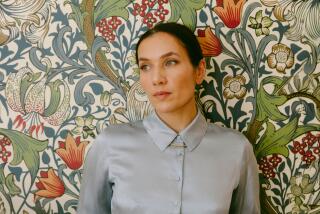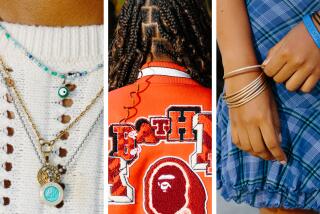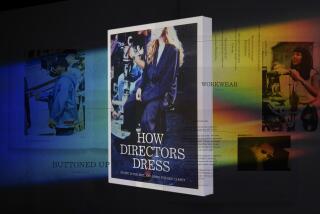Go to Pieces
- Share via
As if the curse of a liberal arts degree weren’t enough, just when a newly minted college graduate most wants to look capable, serious and adult, he or she surveys a closet full of sweats, overalls and jeans--and despairs. It seems silly that a mind that aced statistics would be flummoxed by the simple act of getting dressed, but the real world, where “I’ll skip this class and sleep in” isn’t an option, can be intimidating.
The problem, however, is not insurmountable.
The challenges facing the grad entering the job market with a wardrobe of play and date clothes are to acquire an outfit to wear to job interviews, then gradually build a wardrobe of pieces that functions as more than the sum of its parts.
For 22-year-old Joyce Pepito, who two weeks ago graduated from UC Irvine with a bachelor’s degree in biology and history, buying a suit to wear on job interviews is a necessary expenditure. During college, when interviewing for “small jobs,” she made do by wearing blazers with dresses.
“I didn’t have the money for a suit. Now I’ll probably have to buy one,” she says. “A couple of my friends have bought one, and they’re wearing the same suit for all of their interviews.”
Pepito and her friends are smart to invest in an interview suit.
Although other tailored clothes such as a coat dress or a sportcoat are sometimes acceptable in interviews, a suit is safest, says Jolene Jennings, a client service representative with the UCI Women’s Opportunities Center in Irvine, which counsels both men and women seeking new careers.
“Even if the interview is held on a company’s casual-dress Friday, I wouldn’t dress down. That old cliche ‘dress for success’ still applies,” Jennings says. “If you’re too casual or sporty, the interviewer won’t take you seriously.”
Unfortunately, graduates launch their job hunts in the summer, when suits strike many as especially stifling.
“They need to wear one anyway, and there are a lot of lightweight ones around,” says Cassandra Clark, general partner of BC & Associates, a career consulting firm in Fullerton.
Guys might be able to get away with a sportcoat and slacks if they’re interviewing in a field where the dress code is relaxed, but a long-sleeved shirt and a tie is “always a must,” she says.
Women need to avoid the bright colors they wore as co-eds and keep their skirts to modest lengths--no more than 3 inches above the knee.
“There’s a general rule. You dress conservatively to show maturity,” Clark says.
For many students, the problem isn’t what to wear but how to pay for it. A suit might be the most expensive piece of clothing they’ve ever purchased.
“Sometimes a suit is a graduation present from Mom and Dad,” says Anna Garza, director of the Career Development Center at Chapman University in Orange.
But for those not so lucky, Garza says, “we do a lot of, ‘Show us what clothes you’ve got and we’ll see what we can put together.’
“Some are really on a tight budget. We talk about discount shopping. We tell them not to feel they have to go to a department store to buy a suit. They can find something at Marshalls. It doesn’t have to be expensive; it just has to look nice.”
Since saving money is important to anyone who doesn’t have a job, we conducted our search for postgraduate clothes at the Camarillo Premium Outlet Mall, where 90 discount stores offer merchandise at prices 25% to 65% below retail. Someone with a little luck and the time to haunt boutique and department store sales can find the same kinds of markdowns but might also be tempted by merchandise at full price.
The outlet center is a one- to two-hour drive from Orange County; off-price shoppers believe that the concentration of stores and the promise of a bargain make the trip worthwhile. With so much available at a big mall, they caution, it helps if you go with a plan rather than wander, hoping to be inspired.
The first thing to hunt for--the perfect interview outfit--will make you look like the professional you hope to become. Yet the range of what’s considered professional varies. Power clothes are beside the point in an office where creativity is top priority and / or most employees never meet the public. Our grads chose traditional outfits for interviews at conservative law offices and skewed deliberately more casual for positions in more artistic fields.
The male and female job candidates relied on classic pieces. Competing for the same job at a computer software firm, she chose a short-skirted navy suit, then wore it with a blue ribbed T-shirt instead of a more formal shirt and let her hair fall naturally, to create a polished but free-spirited image.
The user-friendly clothes Michael Douglas wore as a middle manager at a computer company in the 1994 film “Disclosure” were the inspiration for our male grad’s single-breasted brown wool tweed jacket. The dress code at computer companies tends to be informal, so the palette could be earthier. After a few paychecks, the jacket will pair well with a new turtleneck sweater and corduroys.
For an interview at a law firm, he found a traditional navy blazer with brass buttons; a striped, button-down shirt; and a plaid tie. The preppy combination is a nice contrast with his long hair, which might give an interviewer pause if his outfit were too trendy. In winter, the blazer will work with gray flannel slacks, and the shirt can go with the first suit he invests in.
Although the items he put together to interview for a spot in an entertainment agency mail room were similar to his legal look, each one was a bit more stylish. The jacket has broader shoulders and a more tapered European fit. Khaki trousers narrow neatly at the ankle. The spread-collared shirt is more sophisticated; the muted print tie, more subtle. His killer accessory is rimless sunglasses.
For her most conservative look, an entry-level position at a marketing or publishing firm, she pulled her hair back in a businesslike low ponytail, then combined a long navy blazer with a cream silk blouse and straight skirt, worn only slightly above the knee. Her low-heeled loafers could never be judged too sexy for the office, and even her tote bag communicates that she’s prepared to take work home, not just heading out with keys and lipstick as she does when the destination is a club.
Because a good jacket is the centerpiece of a new wardrobe for work, it makes sense to invest the most money there and skimp on tops and bottoms that go with it, if necessary.
*
Styling by Lauren Beck. Hair and makeup by Shannon Frost for Cloutier.
* Kathryn Bold contributed to this report.






